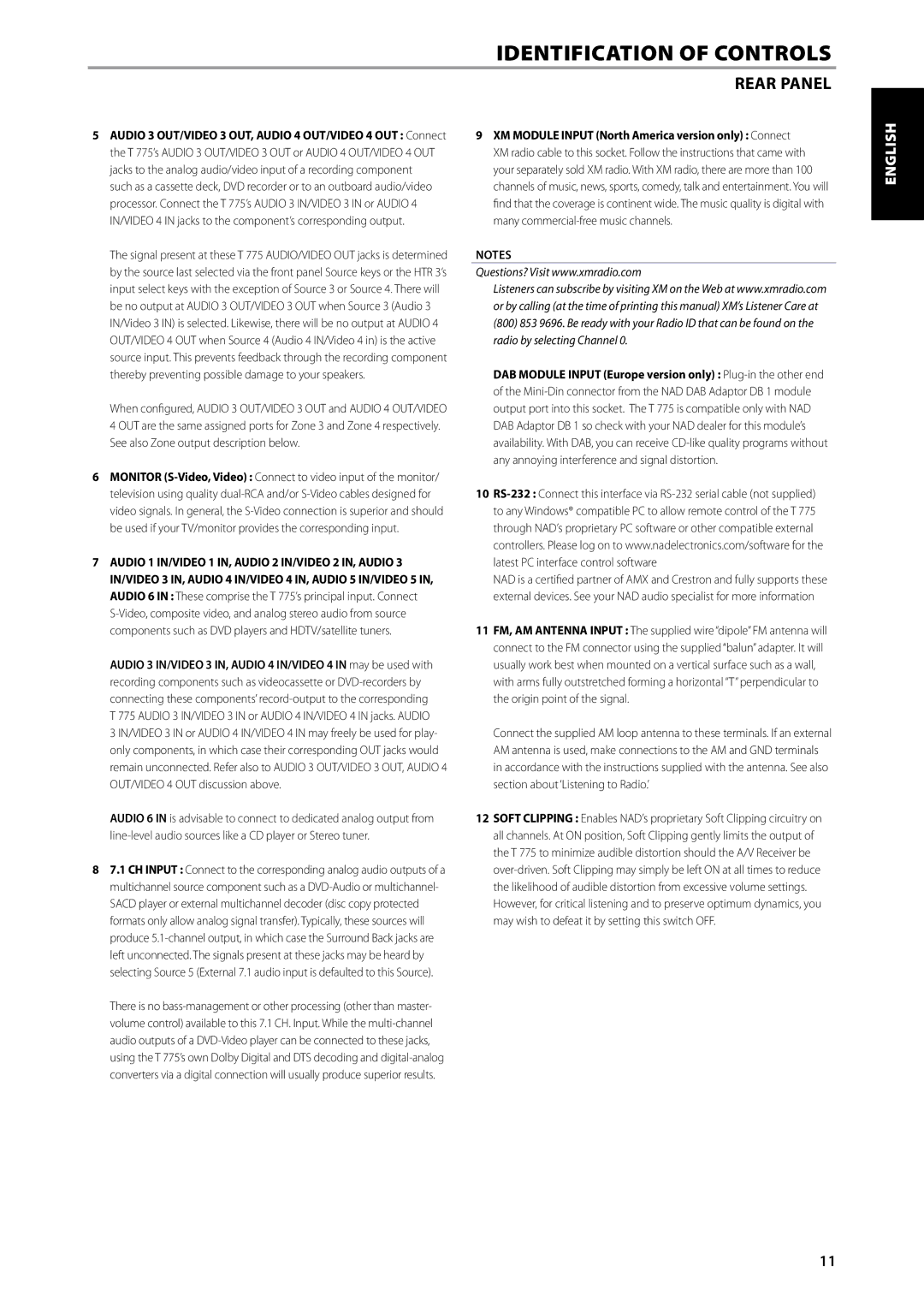5AUDIO 3 OUT/VIDEO 3 OUT, AUDIO 4 OUT/VIDEO 4 OUT : Connect the T 775’s AUDIO 3 OUT/VIDEO 3 OUT or AUDIO 4 OUT/VIDEO 4 OUT jacks to the analog audio/video input of a recording component such as a cassette deck, DVD recorder or to an outboard audio/video processor. Connect the T 775’s AUDIO 3 IN/VIDEO 3 IN or AUDIO 4 IN/VIDEO 4 IN jacks to the component’s corresponding output.
The signal present at these T 775 AUDIO/VIDEO OUT jacks is determined by the source last selected via the front panel Source keys or the HTR 3’s input select keys with the exception of Source 3 or Source 4. There will be no output at AUDIO 3 OUT/VIDEO 3 OUT when Source 3 (Audio 3 IN/Video 3 IN) is selected. Likewise, there will be no output at AUDIO 4 OUT/VIDEO 4 OUT when Source 4 (Audio 4 IN/Video 4 in) is the active source input. This prevents feedback through the recording component thereby preventing possible damage to your speakers.
When configured, AUDIO 3 OUT/VIDEO 3 OUT and AUDIO 4 OUT/VIDEO 4 OUT are the same assigned ports for Zone 3 and Zone 4 respectively. See also Zone output description below.
6MONITOR (S-Video, Video) : Connect to video input of the monitor/ television using quality dual-RCA and/or S-Video cables designed for video signals. In general, the S-Video connection is superior and should be used if your TV/monitor provides the corresponding input.
7AUDIO 1 IN/VIDEO 1 IN, AUDIO 2 IN/VIDEO 2 IN, AUDIO 3 IN/VIDEO 3 IN, AUDIO 4 IN/VIDEO 4 IN, AUDIO 5 IN/VIDEO 5 IN, AUDIO 6 IN : These comprise the T 775’s principal input. Connect S-Video, composite video, and analog stereo audio from source components such as DVD players and HDTV/satellite tuners.
AUDIO 3 IN/VIDEO 3 IN, AUDIO 4 IN/VIDEO 4 IN may be used with recording components such as videocassette or DVD-recorders by connecting these components’ record-output to the corresponding T 775 AUDIO 3 IN/VIDEO 3 IN or AUDIO 4 IN/VIDEO 4 IN jacks. AUDIO
3 IN/VIDEO 3 IN or AUDIO 4 IN/VIDEO 4 IN may freely be used for play- only components, in which case their corresponding OUT jacks would remain unconnected. Refer also to AUDIO 3 OUT/VIDEO 3 OUT, AUDIO 4 OUT/VIDEO 4 OUT discussion above.
AUDIO 6 IN is advisable to connect to dedicated analog output from line-level audio sources like a CD player or Stereo tuner.
87.1 CH INPUT : Connect to the corresponding analog audio outputs of a multichannel source component such as a DVD-Audio or multichannel- SACD player or external multichannel decoder (disc copy protected formats only allow analog signal transfer). Typically, these sources will produce 5.1-channel output, in which case the Surround Back jacks are left unconnected. The signals present at these jacks may be heard by selecting Source 5 (External 7.1 audio input is defaulted to this Source).
There is no bass-management or other processing (other than master- volume control) available to this 7.1 CH. Input. While the multi-channel audio outputs of a DVD-Video player can be connected to these jacks, using the T 775’s own Dolby Digital and DTS decoding and digital-analog converters via a digital connection will usually produce superior results.
9XM MODULE INPUT (North America version only) : Connect XM radio cable to this socket. Follow the instructions that came with your separately sold XM radio. With XM radio, there are more than 100 channels of music, news, sports, comedy, talk and entertainment. You will find that the coverage is continent wide. The music quality is digital with many commercial-free music channels.
Notes
Questions? Visit www.xmradio.com
Listeners can subscribe by visiting XM on the Web at www.xmradio.com or by calling (at the time of printing this manual) XM’s Listener Care at
(800)853 9696. Be ready with your Radio ID that can be found on the radio by selecting Channel 0.
DAB MODULE INPUT (Europe version only) : Plug-in the other end of the Mini-Din connector from the NAD DAB Adaptor DB 1 module output port into this socket. The T 775 is compatible only with NAD DAB Adaptor DB 1 so check with your NAD dealer for this module’s availability. With DAB, you can receive CD-like quality programs without any annoying interference and signal distortion.
10RS-232 :Connect this interface via RS-232 serial cable (not supplied) to any Windows® compatible PC to allow remote control of the T 775 through NAD’s proprietary PC software or other compatible external controllers. Please log on to www.nadelectronics.com/software for the latest PC interface control software
NAD is a certified partner of AMX and Crestron and fully supports these external devices. See your NAD audio specialist for more information
11FM, AM ANTENNA INPUT : The supplied wire “dipole” FM antenna will connect to the FM connector using the supplied “balun” adapter. It will usually work best when mounted on a vertical surface such as a wall, with arms fully outstretched forming a horizontal “T” perpendicular to the origin point of the signal.
Connect the supplied AM loop antenna to these terminals. If an external AM antenna is used, make connections to the AM and GND terminals in accordance with the instructions supplied with the antenna. See also section about ‘Listening to Radio.’
12SOFT CLIPPING : Enables NAD’s proprietary Soft Clipping circuitry on all channels. At ON position, Soft Clipping gently limits the output of the T 775 to minimize audible distortion should the A/V Receiver be over-driven. Soft Clipping may simply be left ON at all times to reduce the likelihood of audible distortion from excessive volume settings. However, for critical listening and to preserve optimum dynamics, you may wish to defeat it by setting this switch OFF.

